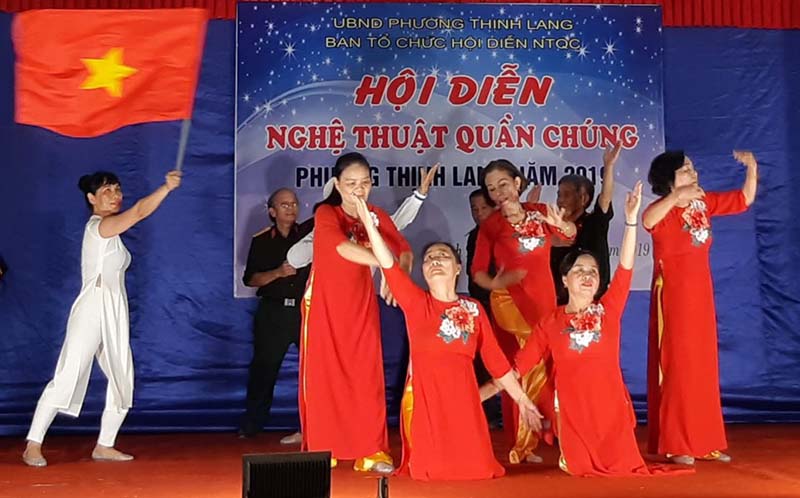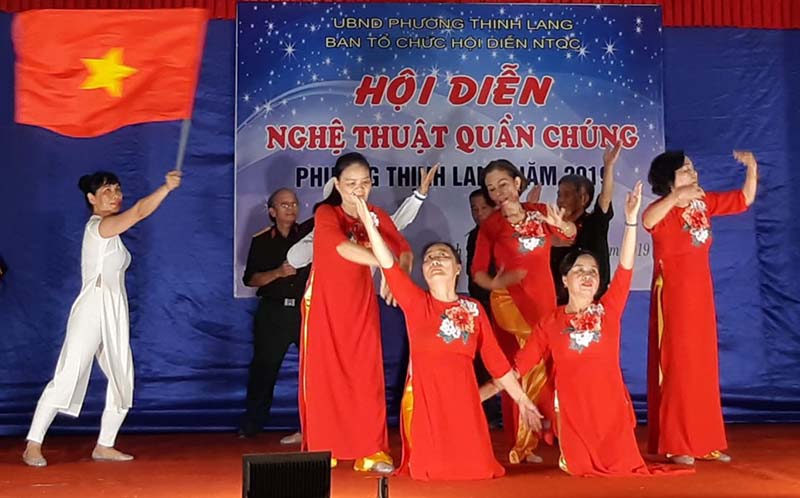
(HBO) - The Public Art Fair of Thinh Lang Ward (Hoa Binh City), which took place in early June 2019, attracted thousands of people to watch and cheer. Nearly 23h, the last performance was completed but everyone was still happy with the endless applause. Nearly 200 performers brought 31 performances of singing, dancing, instrumental performances, Muong gong.

Performances at the Thinh Lang Ward's Public
Art Festival (Hoa
Binh City)
in 2019.
The festival has the
participation of all classes of people, from teenagers to women, veterans,
elderly people, farmers, workers, officials ... There are silver-headed men and
women but they still enthusiastically perform. Some leaders, deputy leaders of
the neighborhood, cell secretary like Mr. Pham Huy Can, Dinh Cong Lap, Mrs.
Nguyen Thi Khuyen... are also performers.
Chairman of the
Fatherland Front of Thinh Lang Ward Nguyen Thi Ngoai commented: Interestingly,
the audience saw the performances of their neighbors, grandfather, grandmother,
mother, grandchildren, brother... Proudly,
the masses are the people who preserve and promote the cultural identity in the
heart of the city. The mass cultural movement in the ward is maintained and
developed vigorously.
Mrs. Nguyen Thi My
Binh, Chairman of the Ward People's Committee said: The mass culture has become
a spiritual food, improving the cultural life for the people. All 9 groups of
the ward have a performance team.
For the movement to
maintain and develop, from the beginning of the year, the Ward People's
Committee issued the operation plan for the whole year. On that basis, the
performance teams perform. Thinh Lang Ward regularly organizes competitions.
Conferences of the gruops and ward often have cultural shows.
Exciting from the
facility, Thinh Lang ward participates in city-level competitions and achieve
high prizes. At the Hoa Binh City Art
Festival in 2017, Thinh Lang ward won the first prize. Every two years,
performances are held again. The Ward will select and actively participate in
the Hoa Binh City Art Festival in 2019, contributing to the development of the
general movement in the area.
With an increasingly vibrant and widespread emulation movement aimed at building cultured residential areas and cultured families, Yen Thuy District has been making steady progress toward improving both the material and spiritual well-being of its people, while fostering a civilized, prosperous, beautiful, and progressive community.
Once lacking recreational spaces and community facilities, Residential Group 2 in Quynh Lam Ward (Hoa Binh City) has recently received attention for the construction of a new, spacious, and fully equipped cultural house. The project followed the model of state support combined with public contributions in both labor and funding.
The "All people unite to build cultural life" movement, which has been effectively integrated with Kim Boi district’s socio-economic development goals, is fostering a lively spirit of emulation across local residential areas, hamlets, villages, public agencies, and enterprises. In addition, through the initiative, traditional cultural values are being preserved and promoted, while community solidarity and mutual support in poverty reduction and economic development are being strengthened.
A working delegation of the Hoa Binh provincial People’s Committee led by its Permanent Vice Chairman Nguyen Van Toan on June 11 inspected the progress of a project to build the Mo Muong Cultural Heritage Conservation Space linked to tourism services in Hop Phong commune, Cao Phong district.
Born and growing in the heroic land of Muong Dong, Dinh Thi Kieu Dung, a resident in Bo town of Kim Boi district, in her childhood was nurtured by the sweet lullabies of her grandmother and mother. These melodies deeply imprinted on her soul, becoming an inseparable part of her love for her ethnic group's culture. For over 20 years, this love for her hometown has driven Dung to research, collect, and pass down the cultural values of the Muong people to future generations.
In the final days of May, the Ethnic Art Troupe of Hoa Binh Province organized performances to serve the people in remote, mountainous, and particularly disadvantaged areas within the province. These were not just ordinary artistic shows, but they were the meaningful journeys aimed at spreading cultural values, enhancing the spiritual life of the people and contributing to the preservation of ethnic minority cultural identities.



